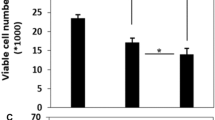Abstract
The majority of breast cancer cell lines are resistant to tumor necrosis factor -related apoptosis inducing ligand (TRAIL) induced apoptosis. TRAIL and Fas receptor death-inducing signaling complex (DISCs) formation are similar and involve ligand-dependent recruitment of FADD and caspase-8. We have found that the breast carcinoma cell line T47D is an unusual example of selective sensitivity to anti-Fas mAb treatment but resistant to TRAIL. Therefore, a detailed comparison of these two signaling pathways in one cell line should provide insight into the mechanism of TRAIL resistance. We observed that only anti-Fas mAb induces caspase activation and cell death in T47D. Further, FADD and caspase-8 interact with both TRAIL-R1 and TRAIL-R2, and that the amount of caspase-8 recruited by Fas-, TRAIL-R1 and TRAIL-R2 are the same. cFLIPS and cFLIPR isoforms block death receptor-induced apoptosis by inhibiting caspase-8 activation at the DISC; the role of cFLIPL at the DISC is still controversial. It has been suggested that the presence of the cleaved form of FLIPL-p43 at the DISC prevents caspase-8 cleavage. We found that both TRAIL and anti-Fas mAb-induced DISCs contain the cleaved form of p43 cFLIPL and its amount at the Fas DISC was higher compared to the TRAIL DISC. We also found that inhibition of cFLIPL expression in T47D cells decreased Fas-mediated caspase-8 activation and activation of effector caspases. We propose that in T47D p43 cFLIPL in the Fas-DISC may promote caspase-8 activation. The mechanism by which different amounts of p43cFLIPL regulates caspase-8 activation remains to be investigated.






Similar content being viewed by others
References
Ashkenazi A, Dixit VM (1998) Death receptors: signaling and modulation. Science 281:1305–1308
Ashkenazi A, Dixit VM (1999) Apoptosis control by death and decoy receptors. Curr Opin Cell Biol 11:255–260
Irmler M, Thome M, Hahne M, Schneider P, Hofman K, Steiner V, Bodmer JL, Schhroter M, Burns K, Mattmann C, Rimoldi D, French LE, Tschopp J (1997) Inhibition of death receptor signals by cellular FLIP. Nature 388:190–195
TschoppJ, Irmler M, Thome M (1998) Inhibition of Fas death signals by FLIPs. Curr Opin Immunol 10:552–558
Golks A, Brenner D, Fritsch C, Krammer PH, Layrik IN (2005) c-FLIPR, a new regulator of death receptor-induced apoptosis. J Biol Chem 280:14507–14513
Kruger A, Schmitz I, Baumann S, Krammer PH, Kirchhoff S (2001) Cellular FLICE-inhibitory protein splice variants inhibit different steps of caspase-8 activation at the CD95 death-inducing signaling complex. J Biol Chem 276:20633–20640
Micheau O, Thome M, Schneider P, Holler N, Tschopp J, Nicholson DW, Briand C, Grutter MG (2002) The long form of FLIP is an activator of caspase-8 at the Fas death-inducing signaling complex. J Biol Chem 277:45162–45171
Schneider P, Thome M, Burns K, Bodmer JL, Hofmann K, Kataoka T, Holler N, Tschopp J. TRAIL receptors 1 (DR4), 2 (DR5) signal FADD-dependent apoptosis and activate NF-kappaB (1997) Immunity 7:831–836
Chaudhary PM, Eby M, Jasmin A, Bookwalter A, Murray J, Hood L (1997) Death receptor 5, a new member of the TNFR family, and DR4 induce FADD-dependent apoptosis and activate the NF-kappaB pathway. Immunity 7:821–830
Keane MM, Ettenberg SA, Nau MM, Russell EK, Lipkoowitz S (1999) Chemotherapy augments TRAIL-induced apoptosis in breast cell lines. Cancer Res 59:734–741
Pan G, O’Rourke K, Chinnaiyan AM, Gentz R, Ebner R, Ni J, Dixit VM (1997) The receptor for the cytotoxic ligand TRAIL. Science 276:111–113
Griffith TS, Chin WA, Jackon GC, Lynch DH, Kubin MZ (1998) Intracellular regulation of TRAIL-induced apoptosis in human melanoma cells. J Immunol 161:2833–2840
Degli-Esposti MA, Dougall WC, Smolak PJ, Waugh JY, Smith CA, Goodwin RG. (1997) The novel receptor TRAIL-R4 induces NF-kappaB and protects against TRAIL-mediated apoptosis, yet retains an incomplete death domain. Immunity 7:813–820
Rokhlin OW, Guseva N, Taghiyev A, Knudson CM, Cohen MB (2001) Bcl-2 oncoprotein protects the human prostatic carcinoma cell line PC3 from TRAIL-mediated apoptosis. Oncogene 20:2836–2843
Rokhlin OW, Glover RA, Cohen MB (1998) Fas-mediated apoptosis in human prostatic carcinoma cell lines occurs via activation of caspase-8 and caspase-7. Cancer Res 58:5870–5875
Rokhlin OW, Guseva NV, Taghiyev AF, Glover RA, Cohen MB. (2004) Multiple effects of N-alpha-tosyl-L-phenylalanyl chloromethyl ketone (TPCK) on apoptotic pathways in human prostatic carcinoma cell lines. Cancer Biol Ther 3:761–768
Rokhlin OW, Guseva NV, Tagiyev AF, Glover RA, Cohen MB (2002) Caspase-8 activation is necessary but not sufficient for tumor necrosis factor-related apoptosis-inducing ligand (TRAIL)-mediated apoptosis in the prostatic carcinoma cell line LNCaP. Prostate 52:1–11
Budanov AV, Sablina AA, Feinstein E, Koonin EV, Chumakov PM (2004) Regeneration of peroxiredoxins by p53-regulated sestrins, homologs of bacterial AhpD. Science 304:596–600
Varfolomeev E, Maecker H, Sharp D, Lawrence D, Renz M, Vicic D, Ashkenazi A (2005) Molecular determinants of kinase pathway activation by Apo2 ligand/tumor necrosis factor-related apoptosis-inducing ligand. J Biol Chem 280:40599–40608
Jin TG, Kurakin A, Benhaga N, Abe K, Mohseni M, Sandra F, Song K, Kay BK, Khosravi-Far R (2004) Fas-associated protein with death domain (FADD)-independent recruitment of c-FLIPL to death receptor 5. J Biol Chem 279:55594–55601
Yang BF, Xao C, Roa Wh, Krammer PH, Hao C (2003) Calcium/calmodulin-dependent protein kinase II regulation of c-FLIP expression and phosphorylation in modulation of Fas-mediated signaling in malignant glioma cells. J Biol Chem 278:7043–7050
Xiao C, Yang BF, Song JH, Schulman H, Li L, Hao C (2005) Inhibition of CaMKII-mediated c-FLIP expression sensitizes malignant melanoma cells to TRAIL-induced apoptosis. Exp Cell Res 304:244–255
Author information
Authors and Affiliations
Corresponding author
Rights and permissions
About this article
Cite this article
Guseva, N.V., Rokhlin, O.W., Taghiyev, A.F. et al. Unique resistance of breast carcinoma cell line T47D to TRAIL but not anti-Fas is linked to p43cFLIPL . Breast Cancer Res Treat 107, 349–357 (2008). https://doi.org/10.1007/s10549-007-9563-2
Received:
Accepted:
Published:
Issue Date:
DOI: https://doi.org/10.1007/s10549-007-9563-2




